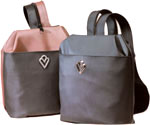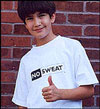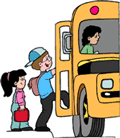The beginning of the school year — already a stressful time for kids and parents — is often made even more difficult by all the purchasing pressure, from long lists of school supplies sent home by teachers to ads promoting fashionable new wardrobes for children. In 2003, Americans will spend $14.1 billion on back-to-school items, with $6.5 billion of that going towards clothes.

In addition to the dent in parents’ wallets, there are environmental and social costs to all this school-related spending. Long before little Chloe or Carson proudly marches into school in that brand-new T-shirt, its manufacturing processes may have dumped toxic pesticides and other chemicals into the environment and into the bodies of exploited workers and their families. That backpack full of supplies might be good for one set of Three Rs — reading, writing, and arithmetic — but bad for another set — reduce, reuse, and recycle. And don’t forget that children have to get to school every day, which often involves burning fossil fuels and exposing kids to diesel fumes while they wait for buses.
This back-to-school report card is designed to help you avoid all the bad stuff, while presenting you and your kids with healthier, fairer choices.
Bad Grades: PVC Shoes, Bags, & Clothes
The most environmentally hazardous plastic, PVC — polyvinyl chloride, better known as vinyl — can be found in shoes, boots, backpacks, and countless other products. “The production of PVC results in dioxins, chlorinated chemicals that are the most toxic and persistent made by humans,” says Lisa Finaldi, coordinator of the toxics campaign of Greenpeace USA. Dioxins, identified as cancer-causing by the U.S. EPA, drift so far and so easily, Finaldi says, that “when these compounds are produced in Minnesota, they will end up in the Arctic Circle.” The chemicals are known to lodge in the fatty tissue of animals and humans, contaminating blood and breast milk. In addition to cancer, they can cause such health problems as organ damage and immune suppression.
As if that weren’t bad enough, soft vinyl contains plasticizers called phthalates, many of which affect reproductive health and sexual development, according to animal experiments. And di-2-ethylhexyl phthalate, which is widely added to soft vinyl products, is considered a probable carcinogen by the U.S. National Toxicology Program. In some studies, phthalates have been shown to migrate out of soft PVC products, so they can be inhaled or ingested. Tests by Greenpeace have also found the toxic heavy metals lead and cadmium in vinyl backpacks and raincoats. Clearly, PVC deserves not only a failing grade but expulsion from the planet.
Good Grades: PVC-Free Products
Shoes: Greenpeace has surveyed athletic-shoe manufacturers to identify those that adhere to a no-PVC policy (e.g. Nike, which is now virtually PVC-free) and those with PVC-phaseout plans (Adidas, Asics, Puma). Check out Greenpeace’s complete list.

Rubber backpacks from Green Earth Office Supply.
Backpacks: Vinyl backpacks are so-o-o-o not cool. Put a greener statement on your back with a stylish hemp backpack from Hemp Sisters or a 100 percent post-consumer recycled rubber knapsack from Green Earth Office Supply.
Bad Grades: Planet-Polluting Clothes
In 2000, 84 million pounds of pesticides were sprayed on the 14.4 million acres of conventional cotton grown in the U.S. (an average of 5.8 pounds of pesticides per acre), according to the U.S. Department of Agriculture — and the EPA considers seven of the top 15 pesticides used on U.S. cotton crops to be “possible,” “likely,” “probable,” or “known” human carcinogens. But don’t just grab any old alternative material instead; polyester, one of the most common cotton substitutes, is made from petroleum-based chemicals. And no matter what fabric you’re wearing, it’s almost certainly been dyed, a process that can release chlorine, chromium, and other pollutants into the environment. Finally, formaldehyde and other toxic volatile organic compounds can be emitted by permanent press, anti-stain, and other fabric treatments.
Good Grades: Earth-Friendly Attire
Organic Cotton: All-around smarter choices are pesticide-free, untreated, uncolored organic cotton garments, or those tinted with natural “fiber-reactive” or “cold pad batch” dyes. Or try naturally “color grown” cotton fibers, often heirloom varieties, that have been bred for colors ranging across the spectrum. High grades also go to wool grown without the use of pesticides and to hemp, a hardy plant that can thrive on far fewer pesticides than cotton, according to the Hemp Industries Association. (At this point, though, there are no organic standards or certification for wool or hemp.)
Used Clothing: Distressed, faded clothing has so much personality that manufacturers have been refining techniques for years to create apparel that looks like fourth-generation hand-me-downs. Why not just buy the real thing? Go on treasure hunts to Salvation Army, Goodwill, or garage sales to find authentic retro styles. And as incentive, you can pass on some of the savings to your kids. (Just to be sure to wash all used items in hot water before they’re worn.)
Green Clothing Sources:
- Maggie’s Functional Organics uses organic cotton, wool, and hemp.
- Earth Wear Organic Cotton Originals sells color-grown (brown, green, natural) organic cotton jeans.
- Garden Kids sells 100 percent organic cotton for young children.
- All of Patagonia‘s cotton is organic, and they use recycled soda bottles in their Synchilla fleece.
- Thirteen Mile Lamb & Wool Company makes organic wool sweaters, hats, scarves, and more.
- Hemp clothing for adults and teens can be ordered from Grass Roots Natural Goods or Rawganique.
- For more clothing resources, check out the International Organic Cotton Directory and the Organic Cotton Site.
Bad Grades: Sweatshop-Made Wearables

No Sweat T-shirt.
Sweatshops are usually associated with developing nations, but they exist in the U.S., too. According to the Hot Fudge Social Venture Fund (a project of Ben & Jerry’s cofounder Ben Cohen), 54 percent of all apparel contractors in Los Angeles have been found guilty of health and safety violations. On average, according to the fund, just six cents of every dollar spent on apparel winds up in the pockets of the workers who made the clothes. To counter these conditions, Hot Fudge developed SweatX, a worker-owned and unionized garment factory that makes casual clothes. Also, Bienestar International, under its No Sweat label, manufactures union-made casual apparel sold exclusively online to offset higher labor costs.
Anti-Sweatshop Resources:
- United Students Against Sweatshops, a coalition of college students on more than 200 campuses, protests unfair labor practices used to make garments that bear university logos.
- For company ratings on social and environmental issues, see Co-op America’s sweatshops.org. For instance, they give Ecolution high marks for both fair wages and pesticide-free hemp garments, while they rate Guess? low for “an advertising campaign that falsely claimed their jeans are 100 percent sweatshop free.”
- The Fair Trade Federation also lists companies committed to “fair wages and good employment opportunities to economically disadvantaged artisans and farmers worldwide.”
Bad Grades: Polluting School Transportation

The bus stops here.
Getting to and from school can be a challenge, particularly given our sprawling communities and consolidation of schools into massive, distant institutions. Busing kids saves gas compared to driving or carpooling, but kids who linger around buses risk exposure to highly polluting diesel fumes, which have been linked to rising asthma rates. For information on how you can help your school district make its bus fleet environmentally friendly, see CleanSchoolBus.org, a campaign promoted by the Union of Concerned Scientists.
Good Grades: Walking & Biking to School
To help counter the effects of sprawl, walking and bicycling are ideal. Not only do they save on pollution and fuel costs, but both are forms of cardiovascular exercise that get kids in touch with your city and community. Wednesday, Oct. 8 is national Walk to School Day, a chance to walk with your children and get some exercise rather than drive or see them off to the school bus. For more information on countering sprawl’s effects on our children, see the article “Suburban Sprawl, Waistline Spread” on the Green Guide website.
Bad Grades: PVC & Chlorine in School Supplies
Miscellaneous school supplies: Although advertised as “wipe-clean,” notebooks, binders, rulers, and pencil cases that contain vinyl leave an indelible smudge on the planet. PVC-free supplies can be purchased from Real Earth Environmental Co. and Mama’s Earth.
Paper: The vast majority of conventional paper products have been bleached with chlorine to make them “paper white.” The problem: This process also creates dioxins. Buy recycled, chlorine-free paper instead, and encourage your local schools to do so too. Dolphin Blue sells 80 percent recycled, chlorine-free office paper and tree-free papers made from scraps or hemp and kenaf. Also see a list of products endorsed by the Chlorine Free Products Association.
Eco-Friendly School & Office Supplies:
Paper
- New Leaf Everest writing paper, with 100 percent post-consumer content and no chlorine bleaching
- Envirographic 100 copy bond paper, with 100 percent post-consumer content and no chlorine bleaching
- Ultimate continuous form computer paper, with 100 percent post-consumer content and no chlorine bleaching
- Dolphin Blue tree-free paper, made from denim, hemp, kenaf, and old money
- Also see the Green Guide’s paper product report and Green Seal for lists of manufacturers.
Desk Supplies
- Deskworks recycled stainless steel scissors, with a handle made of at least 30 percent post-consumer plastic
- 3M Scotch designer tape dispenser, containing at least 50 percent post-consumer plastic
- Nature Saver recycled paper clips, containing 25 percent post-consumer recycled metal
- 3M Post-it recycled paper notes, made of 100 percent recycled paper fiber with 30 percent post-consumer content (Office Depot)
- Acme Kleen Earth 12″ recycled plastic ruler, made from 70 percent post-consumer recycled plastic
- At-A-Glance DayMinder planners and appointment books, containing recycled paper with 30 percent post-consumer fibers)
- Safco half-quart fire-safe wastebasket, made from 25 percent recycled steel
Notebooks, Binders, & File Folders
- Mead recycled wirebound notebooks, with 20 percent post-consumer fibers
- Samsill recycled binders
- Globe-Weis 100 percent recycled color file folders, with 40 percent post-consumer recycled materials
Pens & Pencils
- Recycled cardboard pens
- Biodegradeable cornstarch pens
- Paper Mate EarthWrite recycled pencils, made from 100 percent recycled materials
Green Office-Supply Retailers & Suppliers
- Dolphin Blue
- Eco-Products
- Ecover
- Green Earth Office Supply
- Green Field Paper Company
- GreenLine Paper Company
- New Leaf Paper
- Naturally Yours
- Office Depot
- OfficeMax
- Recycled Products Purchasing Cooperative
- Seventh Generation
- Staples
- Real Earth Environmental Co.
- Treecycle Recycled Paper
Additional research and reporting conducted by P. W. McRandle.


